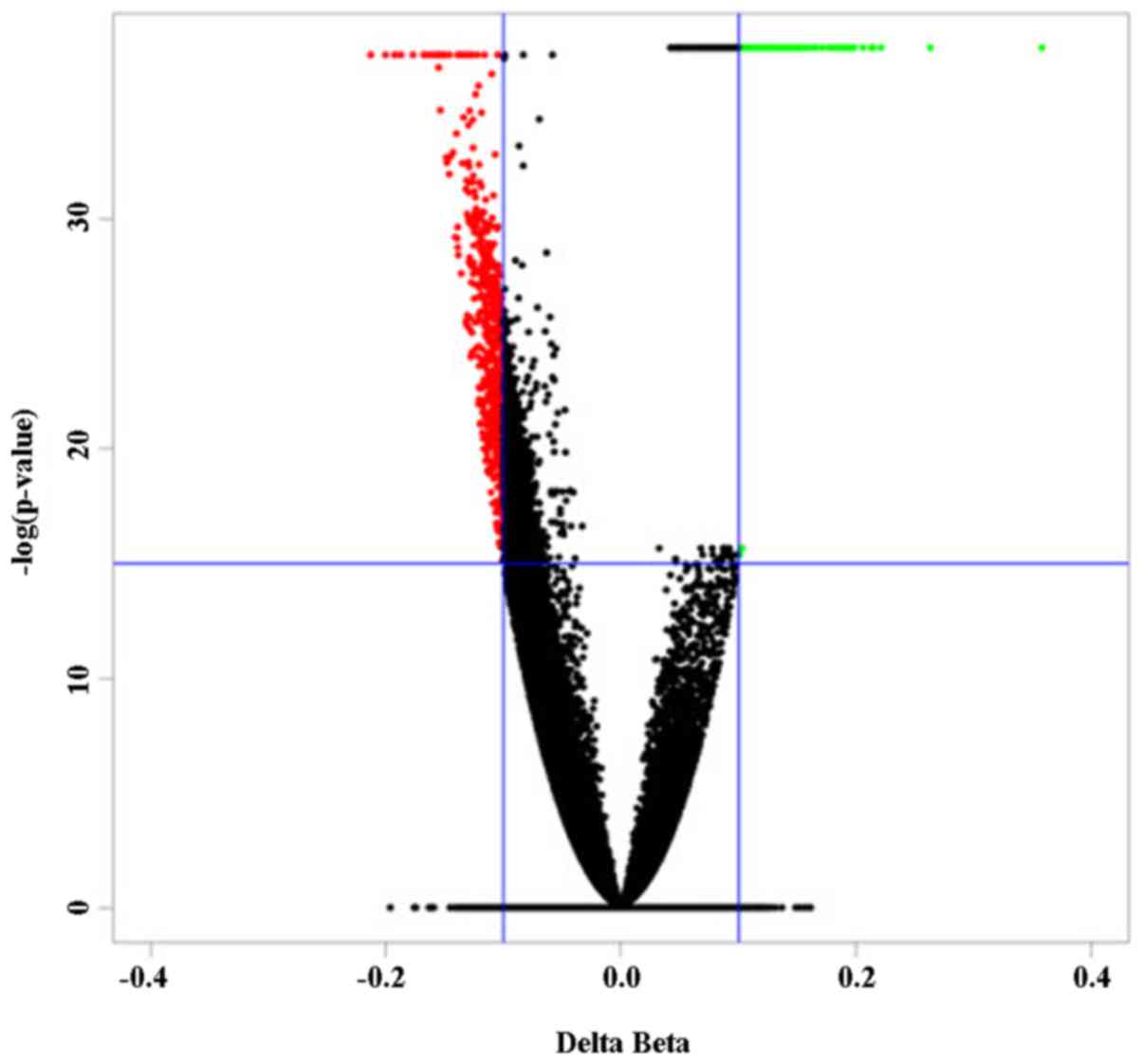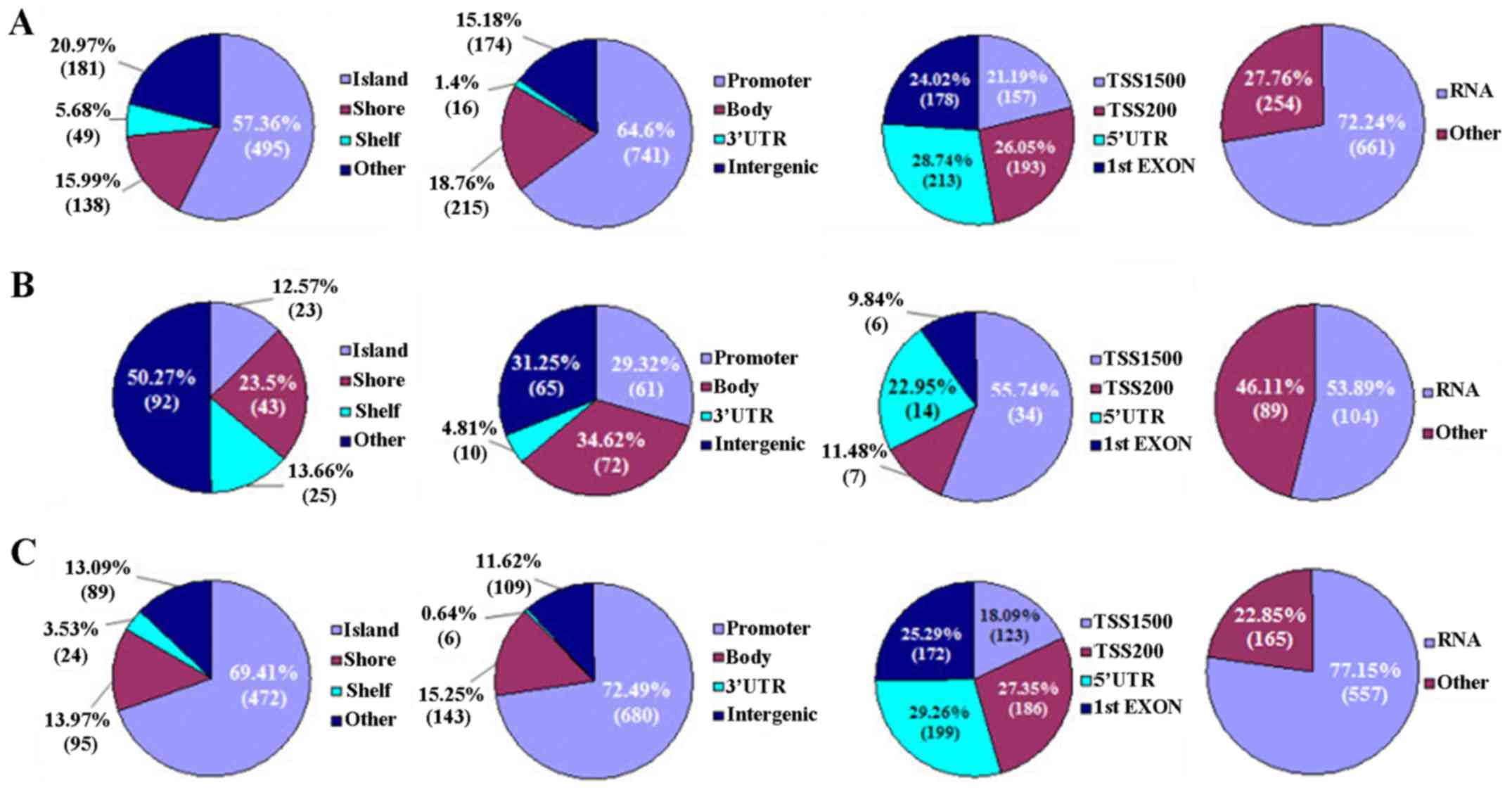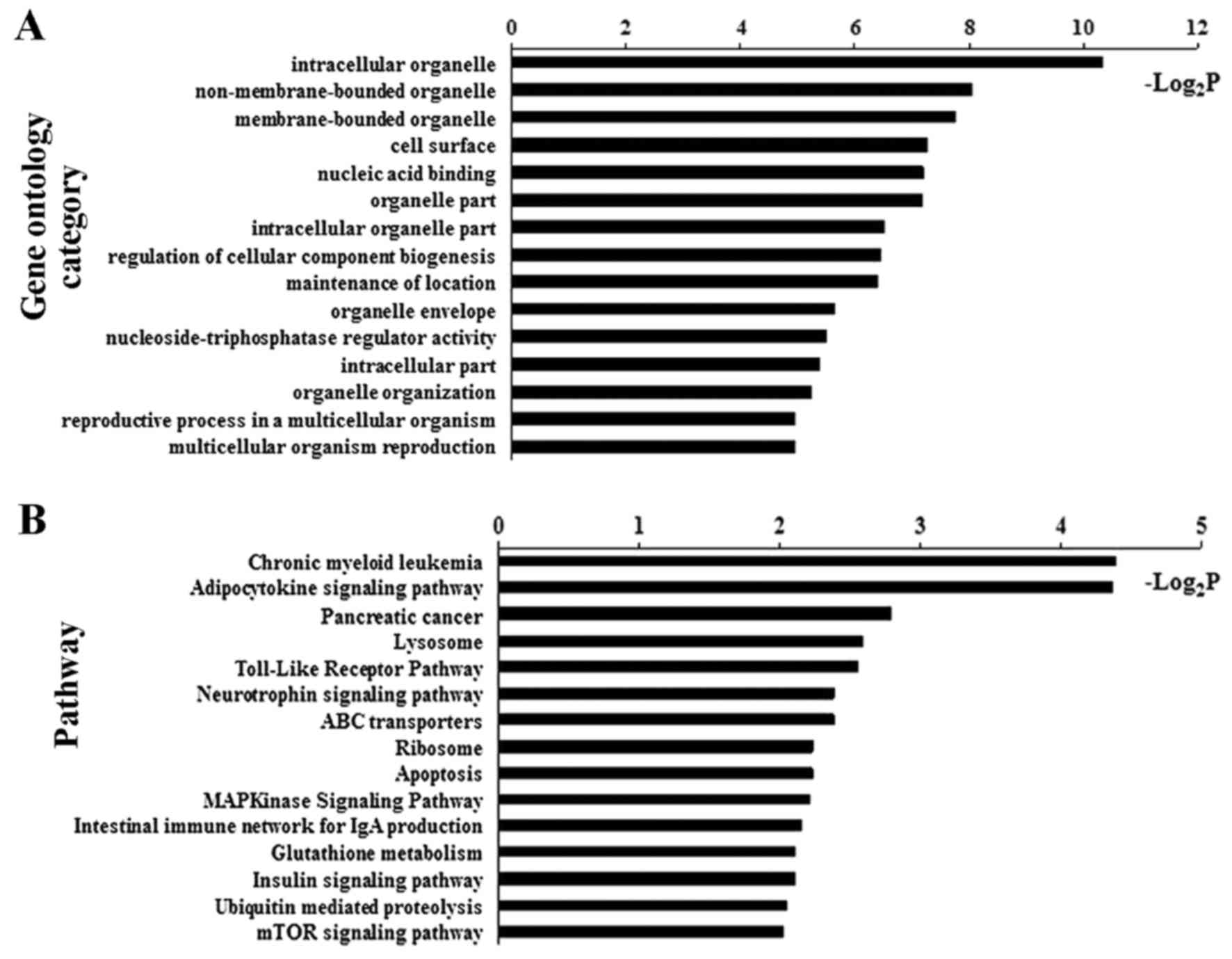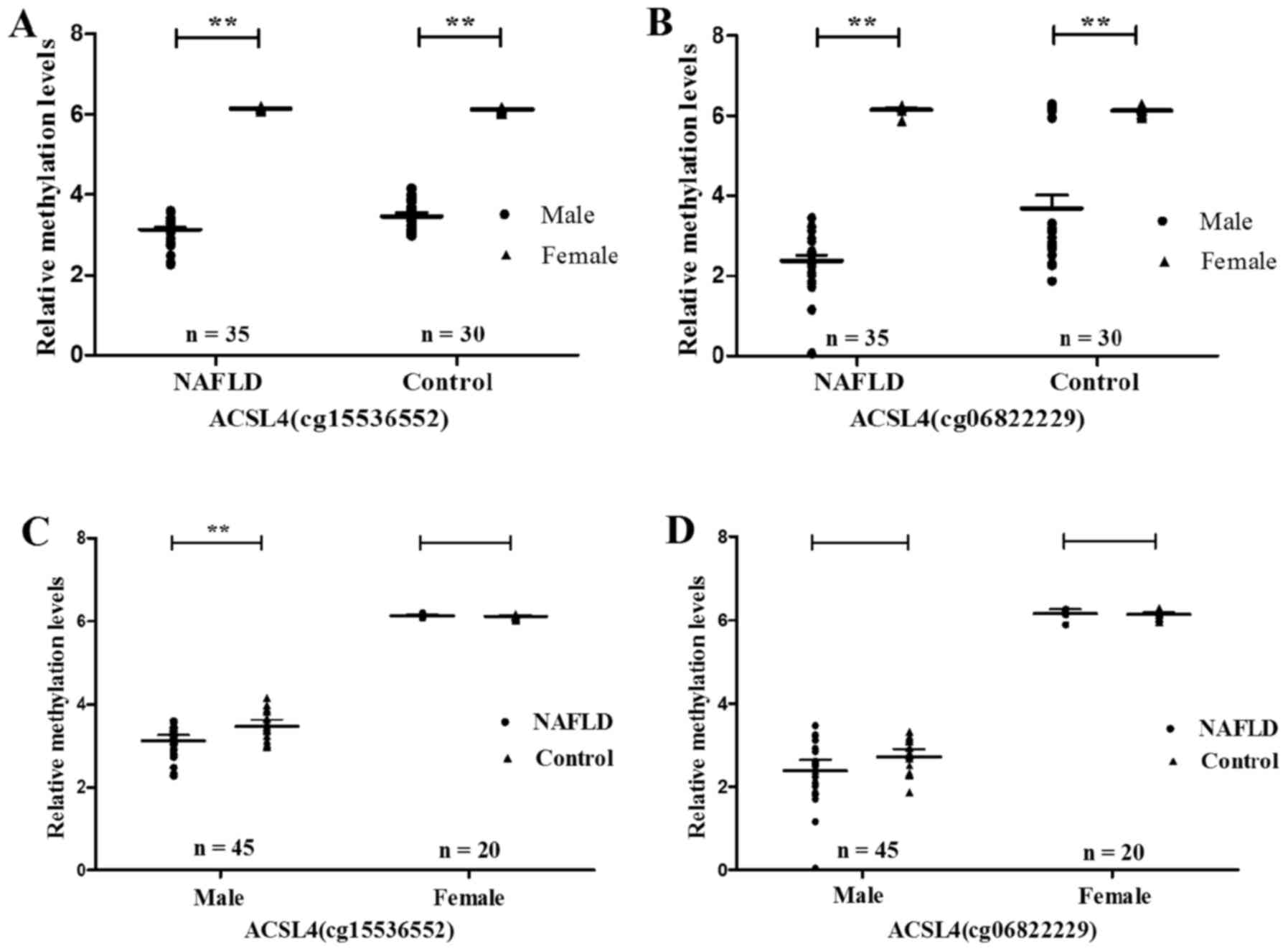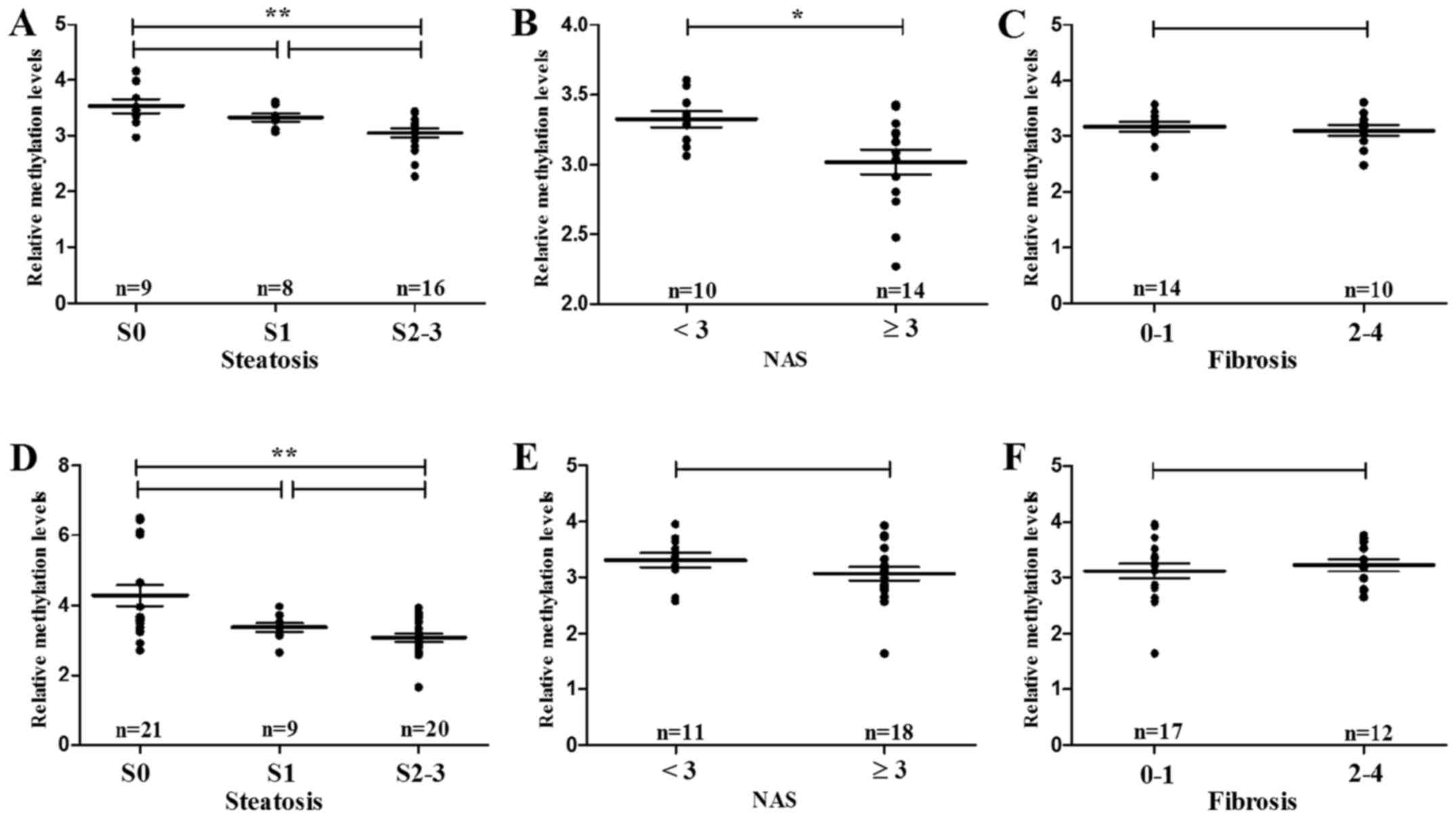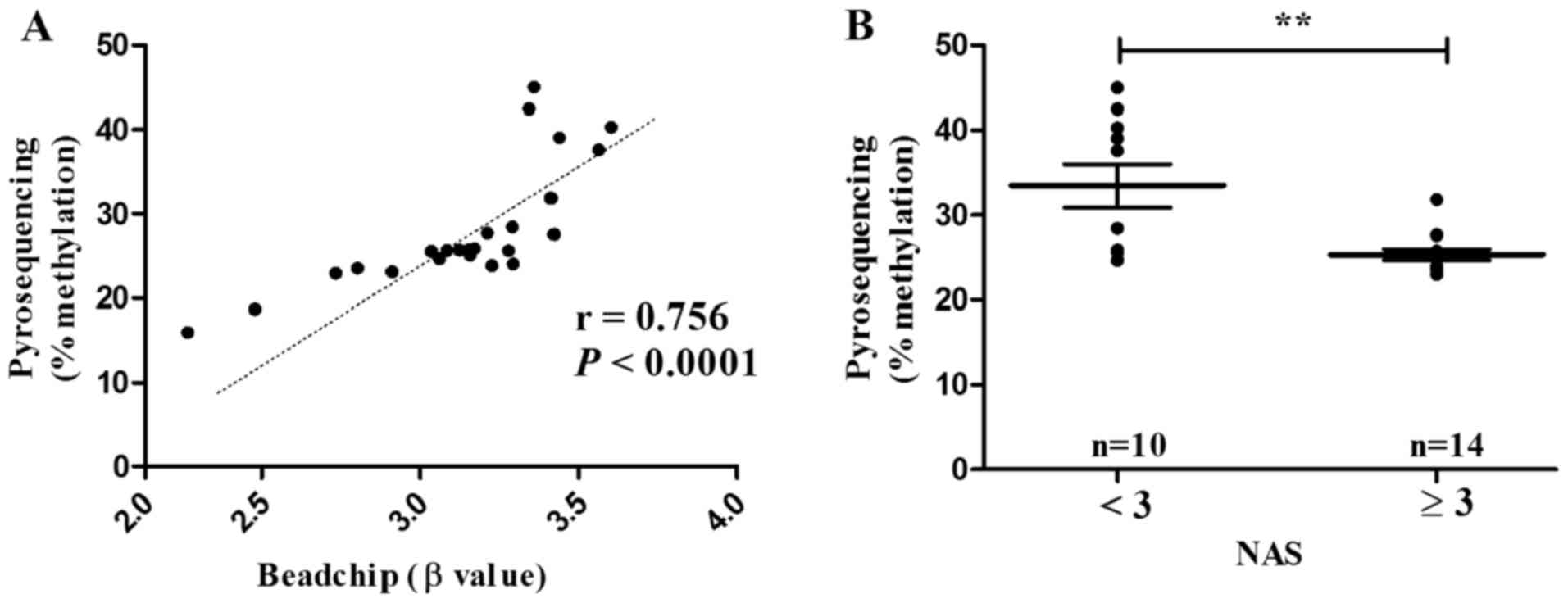Genome-wide analysis of DNA methylation in human peripheral leukocytes identifies potential biomarkers of nonalcoholic fatty liver disease
- Authors:
- Published online on: March 22, 2018 https://doi.org/10.3892/ijmm.2018.3583
- Pages: 443-452
Abstract
Introduction
Nonalcoholic fatty liver disease (NAFLD) is a metabolic-related liver disease associated with obesity, insulin resistance (IR), type 2 diabetes mellitus (T2DM), and other components of the metabolic syndrome (MetS). Proportionally, it is now the most common chronic liver disease worldwide (1). The spectrum of NAFLD ranges from nonalcoholic fatty liver (NAFL), nonalcoholic steatohepatitis (NASH), liver cirrhosis and hepatocellular carcinoma (HCC). Multiple mechanisms are considered to underlie NAFLD, such as oxidative stress, mitochondrial dysfunction, endoplasmic reticulum stress, and bacterial endotoxins (1).
It is well known that genetic factors play an important role in NAFLD. Recently, epigenetic factors (DNA methylation, histone modifications and noncoding RNA) have also been uncovered to serve as the molecular basis of NAFLD (2,3). Of these epigenetic factors, DNA methylation reflects a level of epigenetic regulation that is closely linked to transcription factor (TF) binding and chromatin accessibility. Upregulated DNA methylation at the gene promoter usually leads to transcriptional repression (4,5). Accumulating proofs have revealed that DNA methylation takes a critical role in the regulation of IR, obesity and T2DM, which are major risk factors for NAFLD. Moreover, methyl-depleted diets are reported to promote NASH in animal models, whereas methyl-rich diets prevent NASH (6,7). Locus-specific and global hypomethylation are also associated with NAFLD (8–10). Thus, DNA methylation may be of great importance in the initiation and progression of NAFLD.
Despite its accuracy in NAFLD diagnosis, liver biopsy is limited in clinical application because of its invasiveness. Ultrasound, another widely used method for NAFLD diagnosis, displays poor sensitivity in patients with mild steatosis (<33%) (11,12). Thus, biomarkers for noninvasive, early diagnosis of NAFLD remained to be explored until now. Fortunately, DNA methylation of peripheral leukocytes is currently employed, serving as alternative for that of organic tissue, in the diagnosis of various diseases (13–16). For example, lowered level of DNA methylation in peripheral blood reflects early T2DM (13). A nested case-control study showed that global hypomethylation in leukocytes may be useful biomarker of HCC susceptibility (16). Genomic DNA methylation in peripheral leukocytes is associated with gastric cancer in a population-based, case-control study (15).
We, therefore, enrolled NAFLD patients and normal controls from Chinese population so as to profile leukocytic DNA methylation. The association between DNA methylation and hepatic pathology was then subjected to evaluation. Characteristic sites of NAFLD-related methylation were filtered, and further assessed for noninvasive diagnosis.
Patients and methods
Study population
A total of 65 unrelated adults (aged 18–70 years) were recruited from March, 2012 to May, 2013. Of these, NAFLD patients were enrolled from Xinhua Hospital, Shanghai, China (n=14); Tianjin Hospital of Infectious Diseases, Tianjin, China (n=4) and Zhengxing Hospital, Zhangzhou, Fujian, China (n=17), respectively. Thirty healthy controls were recruited accordingly. All subjects were Han Chinese in origin. Each patient underwent both ultrasound-guided percutaneous liver biopsy and FibroScan® 502 (Echosens, Paris, France) examination, and met the diagnostic criteria for NAFLD (1). The exclusion criteria were as follows: i) excessive alcohol consumption (>30 g/day for males and >20 g/day for females); ii) other diseases that led to fatty liver, such as chronic hepatitis C, drug-induced liver injury, Wilson's disease, total parenteral nutrition, and autoimmune hepatitis; iii) previous liver transplantation; and iv) other end-stage disease or malignancy. All control subjects were confirmed to be free of liver diseases by B-mode ultrasound and FibroScan examination [controlled attenuation parameter (CAP) <240 dB/m and liver stiffness measurement (LSM) values <7.0 kPa] (17,18). These subjects demonstrated normal liver function without evidence of liver injury. The study protocol was approved by the Ethics Committee of Xinhua Hospital in accordance with the Declaration of Helsinki. All participants were enrolled under informed consent.
Clinical and laboratory evaluation
Demographic and anthropometric measurements were carried out in NAFLD patients and normal controls, including sex, age, body mass index [BMI, weight (kg)/height (m)2], and waist-to-hip ratio [WHR, waist circumference (cm)/hip circumference (cm)]. Biochemical tests were conducted, including fasting blood glucose (FBG), fasting serum insulin, total cholesterol (TC), triglycerides (TG), high-density lipoprotein cholesterol (HDL-C), low-density lipoprotein cholesterol (LDL-C), alanine transaminase (ALT), aspartate transaminase (AST), γ-glutamyl-transpeptidase (GGT), total bilirubin (TBIL), direct bilirubin (DBIL), and uric acid (UA). All biochemical parameters were measured using a conventional automated analyzer (7600; Hitachi, Tokyo, Japan). Homeostasis model assessment of insulin resistant (HOMA-IR) was used to evaluate IR: HOMA-IR = fasting serum insulin (µIU/ml) x fasting plasma glucose (mmol/l)/22.5.
Liver histology
Percutaneous liver biopsy was performed in all NAFLD patients under real-time ultrasound guidance. Biopsy specimens were then formalin-fixed, paraffin-embedded, sectioned, and treated with hematoxylin and eosin (H&E), Masson's and reticulin staining. Histological changes were assessed according to Kleiner's classification, with the NALFD activity score (NAS) based on steatosis, lobular inflammation and hepatocyte ballooning (19). Patients with NAS <3 were excluded of NASH. While those with NAS of 3–4 (at least 1 for ballooning degeneration), and ≥5 were diagnosed to be borderline NASH, and NASH, respectively. Liver fibrosis was staged as follows: F0, none; F1, perisinusoidal or portal fibrosis; F2, perisinusoidal and periportal fibrosis without bridging; F3, bridging fibrosis; and F4, cirrhosis (20).
DNA extraction and bisulfite conversion
Genomic DNA was extracted from peripheral blood samples obtained from each subject using the nucleic acid extraction kit (Qiagen, Hilden, Germany). The DNA quality was determined by a NanoDrop 2000c spectrophotometer (Thermo Fisher Scientific Inc., Wilmington, DE, USA). Bisulfite conversion of DNA (500 ng/sample) was then performed by the EZ DNA meth-ylation kit (Zymo Research, Irvine, CA, USA) according to the manufacturer's protocol, with a modified thermo-cycling procedure as suggested by Illumina (San Diego, CA, USA). The protocol included 16 cycles of denaturing at 95°C for 30 sec, incubation at 50°C for 60 min, and a final holding step at 4°C.
Methylation analysis
The Human Methylation 450K BeadChip (Illumina) was used to analyze the genome-wide DNA methylation profile across 485 577 loci distributed in promoters, gene bodies, 3′-untranslated regions (3′-UTR), and intergenic regions, respectively. In detail, bisulfite-converted DNA (4 µl) was hybridized with the Methylation 450K BeadChip following the Illumina Infinium HD Methylation protocol. Illumina's Genome Studio® Methylation module version 1.0 (Illumina) was employed to calculate the methylation level at each CpG site by β-value [β=intensity of the methylated allele (M)/(intensity of the unmethylated allele (U) + intensity of the methylated allele (M) + 100)]. The obtained β-values, ranging from 0 (fully unmethylated) to 1 (fully methylated), was further normalized by R package (Partek Inc., St. Louis, MO, USA) (21). Resultantly, average Δ-β-value was calculated to indicate the differential methylation between NAFLD patients and controls. Quality control inclusion valuation depended on hybridization detection P-values of <0.05. DNA loci with differential methylation were filtered by Δ-β-value and DiffScore as follows (21,22): DiffScore=10Sign (βNAFLD−βcontrols) log10P.
Bioinformatics analysis
The effect of differentially methylated sites on biological functions was analyzed by gene ontology (GO). Moreover, KEGG algorithm was used to identify signaling pathways that significantly related to the differentially methylated sites. The false discovery rate (FDR) was employed to exclude false positive results (23,24).
Pyrosequencing
Acyl-CoA synthetase long-chain family member 4 (ACSL4) was filtered for validation using pyrosequencing. In detail, forward, GTGATGGATTTTGGGGTTTT, reverse, AAAACTCCCTAACCCTCAATTAC and sequencing primers, GTATTTAGAGGGTTAGAAGTTAT were designed with PyroMark Assay Design software (version 2.0; Qiagen). Bisulfite treated DNA was amplified by PCR using the PyroMark PCR kit (Qiagen). The pyrosequencing assay was then performed on a PyroMark Q96 instrument using the PyroMark Gold Q96 kit (both from Qiagen). The sequencing results were analyzed using the PyroMark CpG software (Qiagen).
Statistical analysis
Continuous variables were determined by the unpaired Student's t-test (data with normal distribution) or Mann-Whitney U test (data with skewed distribution). Comparative analyses of categorical variables were carried out using the Chi-square test. Fisher's exact test and Chi-square test were employed to classify the GO category and significant signaling pathways, respectively. Two-way ANOVA was used to compare groups with two independent variables (age and sex). Because of its non-normal distribution, methylation level of CpG sites was analyzed after log2 transformation. The optimal cut-off value for each CpG site was determined by maximizing the Youden index. CpG sites with methylated levels ≥ and < optimal cut-off were defined as high, and low methylation, respectively. Multivariate regression analysis was then performed to identify independent risk CpG sites for NAFLD or NASH. In addition, the diagnostic efficiency for risk CpG sites was analyzed by area under the receiver operating characteristic curves (AUC) and 95% confidence interval (CI). All statistical analyses were performed by SPSS 13.0 software (SPSS, Inc., Chicago, IL, USA). A two-tailed P<0.05 was considered statistically significant. The statistical methods used in this study were reviewed by Dr Guang-Yu Chen from Clinical Epidemiology Center, Shanghai Jiao Tong University.
Results
Clinical characteristics of the study population
The clinical characteristics of the study population are outlined in Table I. When compared to those of control group, levels of BMI, WHR, ALT, GGT, TG, TC, HDL-C, LDL-C, UA, CAP and LSM were significantly higher in the NAFLD group (P<0.01–0.05).
DNA methylation profile of peripheral leukocytes differentiated NAFLD patients from normal controls
When compared to those of normal controls, a panel of 863 differentially methylated (DM) CpG sites in peripheral blood cells characterized the NAFLD patients (Fig. 1). Among these DM sites, 183 (21.2%) were hypermethylated in NAFLD patients, whereas 680 sites (78.8%) were hypomethylated.
According to genomic location, CpG sites distribute in CpG islands (CGIs), shores [0–2 kilobase (kb) from CpG islands], shelves (2–4 kb from CpG islands) and other/open sea, respectively. On the other hand, the location of CpG sites is classified as promoter, gene body, 3′-UTR and intergenic, respectively. The promoter is further divided into surrounding transcription sites (TSS −200 to −1500 bp, TSS200 and TSS1500), 5′-UTR and 1st exon, respectively (Fig. 2).
In the present study, most DM CpG sites (57.36%) localized in CGIs, followed by 20.97 and 15.99% in the other/open sea and shore regions, respectively. On the contrary, these CpG sites were enriched in promoter (64.60%), and less likely to be in the gene body (18.76%), intergenic regions (15.18%), and 3′-UTR (1.4%). In the promoter, the DM CpG sites usually distributed in the TSS1500, TSS200, 5′-UTR and 1st exon regions (Fig. 2A).
Methylatively, hypermethylated CpG sites dominated the other/open sea (50.27%) and gene body (34.62%), respectively. In the promoter, most hypermethylated CpG sites (55.74%) localized in TSS500 (Fig. 2B). In contrast, the hypomethylated CpG sites predominantly located in CGIs (69.41%) and promoter (72.49%), respectively. In the promoter, these hypomethylated CpG sites were likely to localize in 5′-UTR (29.26%) (Fig. 2C). Taken together, the DM CpG sites (hyper- or hypomethylated sites) were predominantly distributed in the RNA coding regions of the genome (Fig. 2).
Differential methylation of the adipocytokine signaling pathway characterized NAFLD patients
Bioinformatic analysis identified GOs and signaling pathways significantly associated with the DM CpG sites in NAFLD patients (Fig. 3 and Table II). Of these, adipocytokine signaling pathway demonstrated one of the top-ranking pathways. Four critical genes, including ACSL4, carnitine palmitoyltransferase 1C (CPT1C), insulin receptor substrate 4 (IRS4) and inhibitor of κ light polypeptide gene enhancer in B-cells, kinase γ (IKBKG), of the adipocytokine signaling pathway were verified to be hypomethylated in their promoter (Table II).
Hypomethylated ACSL4 (cg15536552) and CPT1C (cg21604803) in adipocytokine signaling pathway conferred susceptibility to NAFLD
When compared to those in the control group, β-values of 2 loci in the ACSL4 gene (cg15536552 and cg06822229) and 1 locus the CPT1C gene (cg21604803) were markedly lower in the NAFLD group (ACSL4 cg15536552, P=0.009; ACSL4 cg06822229, P=0.023; CPT1C cg21604803, P=0.004) (Table III). No significant differences could be found in other loci between the NAFLD patients and controls.
After grouping by sex and age, the ACSL4 (cg15536552 and cg06822229) methylation level was proved to be significantly higher in females than in males, regardless whether NAFLD patients (ACSL4 cg15536552, P<0.0001; ACSL4 cg06822229, P<0.0001) or normal controls (ACSL4 cg15536552, P<0.0001; ACSL4 cg06822229, P<0.0001) (Fig. 4A and B). Nevertheless, male NAFLD patients demonstrated methylation levels of ACSL4 (cg15536552 and cg06822229) much lower than those in the normal controls correspondingly (ACSL4 cg15536552, P=0.007; ACSL4 cg06822229, P=0.035) (Fig. 4C and D). As compared to that of normal controls, the methylation values of ACSL4 (cg15536552) and CPT1C (cg21604803) were also significantly lower in NAFLD patients ≤50 years (ACSL4 cg15536552, P=0.009; CPT1C cg21604803, P=0.001) (Fig. 5).
Moreover, hypomethylation of ACSL4 (cg15536552) and CPT1C (cg21604803) was proved to increase the risk of NAFLD (ACSL4 cg15536552, OR: 10.50, 95% CI: 1.70–64.99, P=0.014; CPT1C cg21604803, OR: 7.67, 95% CI: 2.14–27.49, P=0.001). After adjusting for BMI and HOMA-IR, the hypomethylated ACSL4 (cg15536552) and CPT1C (cg21604803) still conferred susceptibility to NAFLD (ACSL4 cg15536552, OR: 11.44, 95% CI: 1.04–125.37, P=0.046; CPT1C cg21604803, OR: 6.57, 95% CI: 1.02–42.15, P=0.047) (Table IV). Their methylation levels, with cut-off β-values of 3.36 (ACSL4 cg15536552) and 3.54 (CPT1C cg21604803), well differentiated NAFLD patients from normal controls (ACSL4 cg15536552, AUC: 0.80, 95% CI: 0.62–0.98, P=0.009, n=33; CPT1C cg21604803, AUC: 0.78, 95% CI: 0.65–0.91, P=0.001, n=50) (Fig. 6A and B).
Table IVACSL4 (cg15536552) and CPT1C (cg21604803) methylation associated with NAFLD and borderline/definitive NASH. |
Hypomethylation of ACSL4 (cg15536552) and CPT1C (cg21604803) associate with histopathological classification
Histopathologically, hypomethylation of ACSL4 (cg15536552) significantly associated with hepatic steatosis (S2–3 vs. S0, P=0.004) and NAS (≥3 vs. <3, P=0.021) (Fig. 7A and B), respectively, in male subjects. However, no significant correlation was found between ACSL4 (cg15536552) methylation and liver fibrosis (F2–4 vs. F0–1, P=0.501) (Fig. 7C). Despite its noncorrelation with NAS and fibrosis, hypomethylation of CPT1C (cg21604803) also conferred high risk to hepatic steatosis (S2–3 vs. S0, P=0.007) (Fig. 7D).
Moreover, patients with ACSL4 (cg15536552) hypomethylation showed increased risk for borderline/definitive NASH (OR: 8.56, 95% CI: 1.33–54.95, P=0.024). After adjusting for BMI and HOMA-IR, ACSL4 (cg15536552) hypomethylation qualify itself for the risk factor of borderline/definitive NASH (OR: 8.72, 95% CI: 1.29–58.78, P=0.026) (Table IV). By receiver operating characteristic (ROC) curve, decreased level of ACSL4 (cg15536552) methylation serve as an index, with the optimum cut-off β-values of 3.26, for borderline/definitive NASH in male NAFLD patients (AUC: 0.79, 95% CI: 0.60–0.97, P=0.019, n=24) (Fig. 6C).
Validation of ACSL4 (cg15536552) methylation by pyro-sequencing
For the sake of its close association with borderline/definitive NASH, ACSL4 (cg15536552) was subjected to validation in male NAFLD patients aged ≤50 (n=24). Indeed, pyrosequencing displayed methylation level of ACSL4 (cg15536552) in parallel to that of methylation 450K BeadChip (r=0.756, P<0.0001) (Fig. 8A). The methylation level of ACSL4 (cg15536552) was also statistically decreased in patients with borderline/definite NASH (NAS ≥3) (P=0.004) (Fig. 8B).
Discussion
NAFLD is generally considered to be the result of environmental, genetic, and epigenetic disorders. DNA methylation reflects one of the most important patterns of epigenetic modification, and mediates cross-talk between environmental and epigenetic factors. To shed light on its role in NAFLD, DNA methylation was recently subjected to profiling in liver tissue. First, hepatic DNA methylation was analyzed by genome-wide profiling in patients with mild to advanced NAFLD (10). Second, global analysis of DNA methylation was carried out, before and after bariatric surgery, in morbidly obese patients with NAFLD (25). Strikingly, altered methylation in CpG sites of genes (i.e., PC, ACLY, PLCG1, IGF1, IGFBP2, PRKCE, ZNF274, FGFR2, MAT1A and CASP1), which regulated glycolipid metabolism, steatohepatitis, fibrosis and carcinogenesis, demonstrated close association with NAFLD in both studies (10,26). Hypermethylated promoter of peroxisome proliferator-activated receptor γ co-activator 1a (PPARGC1A) significantly correlated to plasma fasting insulin and HOMA-IR (8). Hypermethylation in the promoter of glucokinase and L-type pyruvate kinase, which lead to downregulation of their transcription, is related to both impaired insulin sensitivity and NAFLD in high-fat diet induced animal models (9,27). Differences in DNA methylation even distinguish patients with advanced versus mild NAFLD (10,26). DNA methylation, therefore, is suggested to be an epigenetic factor deeply involved in NAFLD.
In spite of its critical role in NAFLD, DNA methylation of liver tissue is prevented from experimental and clinical application due to the difficulty in sample collection. Fortunately, peripheral leukocytes instead of organic tissue, has now been employed in the profiling of DNA methylation related to various diseases, such as cancers and myelodysplastic syndrome (13,14,16,25,28). As compared to that of normal controls, a CpG site in the first intron of FTO shows significant hypomethylation in the peripheral leukocytes of patients with type 2 diabetes (13). Increased risk for different types of cancer (colon, bladder, stomach, breast, head and neck cancer) has been found in cohorts with the lowest quartile of leukocytic DNA methylation (15,29–35). Thus DNA methylation of peripheral leukocytes, serving as alternative for organic tissue to some extent, may be potential in the identification of NAFLD.
In the present study, genome-wide profiling of DNA methylation was performed in the peripheral leukocytes obtained from both NAFLD patients and normal controls. In total, 863 DM CpG sites characterized the groups of NAFLD patients. In detail, the percentage of hyper- and hypomethylated loci in the coding region was much higher than that in other regions of the genome. According to the non-coding region of genome, hypo- and hypermethylated loci were abundant in the CGIs of promoter and intergenic region, respectively. These findings indicate that the DM loci, although numerically limited, are highly enriched in the biological regions of the genome.
Dramatically, genomic hypomethylation, representing 78.8% of DM loci, reflected the methylatic characteristics of peripheral leukocytes in NAFLD patients. Hypo- rather than hypermethylation, with 76% of DM loci, already reported to dominate the genome of liver tissues in patients with advanced NAFLD (10). Hypomethylation also serves as the epigenetic characteristics of alcohol-related fatty liver disease (10). It is further uncovered to underlie the animal model of NASH induced by methyl-deficient diet (36). Taken together, hepatocytes and leukocytes of NAFLD patients share the same pattern of DNA methylation, that of global hypomethylation (10).
NAFLD-related DM loci of peripheral leukocytes were then subjected to bioinformatic analysis on the basis of GO and KEGG algorithm. Interestingly, multiple hypomethylated CpG sites were focused in critical genes, including ACSL4 (cg15536552, cg06822229, cg08855111, cg19635884, cg26119746, cg09091181 and cg10721440), CPT1C (cg21604803), IRS4 (cg06779802) and IKBKG (cg08417382, cg02869694, cg00813156, cg08560117 and cg08873063), of adipocytokine signaling pathway. When compared to those in the control group, NAFLD patients suffered from significantly lowered β-values in 2 loci of the ACSL4 gene (cg15536552 and cg06822229) and 1 locus of the CPT1C gene (cg21604803). ACSL4, an important enzyme regulating the intracellular level of unesterified arachidonic acid (AA), has been reported overexpressed in African-American patients with NAFLD or NASH (37). Hepatic fat content and steroid synthesis are also significantly associated with ACSL4 even after adjustment for BMI (38). Functional studies have shown that upregulated ACSL4 accelerates lipogenesis, whereas downregulated ACSL4 prevents the accumulation of cellular cholesterol (39). On the other hand, CPT1C (isoform of CPT1) plays a vital role in the mitochondrial β-oxidation, energy balance, and hepatic glucose homeostasis. These results are supposed to reflect the differentially methylated effect of both peripheral leukocytes and liver tissue in response to lipogenetic stimuli, and potentiate leukocytic DNA methylation to be noninvasive biomarker for NAFLD.
Indeed, statistically hypomethylated ACSL4 (cg15536552) and CPT1C (cg21604803) in peripheral leukocytes associated with the grade of liver steatosis in this study. Both loci were verified to be independent variables and risk factors of NAFLD, even after the adjustment for age, sex and BMI and HOMA-IR. Their accuracy for the diagnosis of NAFLD, as evaluated by ROC curves, was 0.80 of ACSL4 cg15536552, and 0.78 of CPT1C cg21604803, respectively. Moreover, the hypomethylation of ACSL4 (cg15536552) served as an independent risk factor for borderline/definitive NASH (NAS ≥3) after the adjustment for BMI and HOMA-IR. Its AUC for the detection of NAS (≥3) was proved to be 0.79. DNA methylation of peripheral leukocytes is qualified for the serum biomarker of NAFLD/NASH with moderate diagnostic efficiency. Noninvasive biomarker for hepatopathological identification, especially NASH, has long been the focus of research and clinical interference. Although multiple indexes [i.e., cytokertin 18 (CK18), procollagen III, adiponectin, ferritin, tumor necrosis factor-α (TNF-α)] have been explored (40–42), limited diagnostic efficiency has made it a difficult task until now. The serum concentration of CK18, an index for hepatocyte apoptosis, exhibits the most promising AUC (0.82) for NASH diagnosis (40–42). Dramatically, hypomethylation of ACSL4 (cg15536552) showed comparable efficacy. Then combination of these 2 biomarkers may provide us with a better solution for the noninvasive diagnosis of NAFLD/NASH.
Some limitations of the study should be considered. First, the DNA methylation was only measured in peripheral leukocytes. Methylation pattern of whole blood has been reported to serve as a good proxy for methylation levels from a specific site of action (43,44). Consistently, both liver tissue and peripheral leukocytes exhibited global hypomethylation. Despite the similarity in methylation pattern, there were still different loci between liver tissue and peripheral leukocytes on the basis of tissue-specific methylation. Second, sample size of the present study was relative limited. Clinical trial with large cohorts would be preferable for the validation of our findings.
In conclusion, NAFLD patients demonstrate global DNA hypomethylation in peripheral leukocytes when compared to that of normal controls. Hypomethylated CpG sites of ACSL4 (cg15536552) and CPT1C (cg21604803), critical genes of adipocytokine signaling pathway, are associated with the increased risk for NAFLD. Lowered methylation level of ACSL4 (cg15536552) serves as an index for borderline/definitive NASH. DNA methylation profiling of peripheral leukocytes, therefore, may identify noninvasive biomarkers with potential for the pathological evaluation of NAFLD.
Acknowledgments
The authors would like to thank Professor Ruidan Zheng and Professor Yuqiang Mi who provided the NAFLD patients, clinical data and blood samples for this manuscript.
References
|
Fan JG, Jia JD, Li YM, Wang BY, Lu LG, Shi JP and Chan LY; Chinese Association for the Study of Liver Disease: Guidelines for the diagnosis and management of nonalcoholic fatty liver disease: update 2010: (published in Chinese on Chinese Journal of Hepatology 2010; 18:163–166). J Dig Dis. 12:38–44. 2011. View Article : Google Scholar : PubMed/NCBI | |
|
Ferreira DM, Simão AL, Rodrigues CM and Castro RE: Revisiting the metabolic syndrome and paving the way for microRNAs in non-alcoholic fatty liver disease. FEBS J. 281:2503–2524. 2014. View Article : Google Scholar : PubMed/NCBI | |
|
Gori M, Arciello M and Balsano C: MicroRNAs in nonalcoholic fatty liver disease: Novel biomarkers and prognostic tools during the transition from steatosis to hepatocarcinoma. Biomed Res Int. 2014:7414652014. View Article : Google Scholar : PubMed/NCBI | |
|
Lopez-Serra L and Esteller M: Proteins that bind methylated DNA and human cancer: Reading the wrong words. Br J Cancer. 98:1881–1885. 2008. View Article : Google Scholar : PubMed/NCBI | |
|
Bian EB, Zhao B, Huang C, Wang H, Meng XM, Wu BM, Ma TT, Zhang L, Lv XW and Li J: New advances of DNA methylation in liver fibrosis, with special emphasis on the crosstalk between microRNAs and DNA methylation machinery. Cell Signal. 25:1837–1844. 2013. View Article : Google Scholar : PubMed/NCBI | |
|
Robertson KD: DNA methylation and human disease. Nat Rev Genet. 6:597–610. 2005. View Article : Google Scholar : PubMed/NCBI | |
|
Komatsu Y, Waku T, Iwasaki N, Ono W, Yamaguchi C and Yanagisawa J: Global analysis of DNA methylation in early-stage liver fibrosis. BMC Med Genomics. 5:52012. View Article : Google Scholar : PubMed/NCBI | |
|
Sookoian S, Rosselli MS, Gemma C, Burgueño AL, Fernández Gianotti T, Castaño GO and Pirola CJ: Epigenetic regulation of insulin resistance in nonalcoholic fatty liver disease: Impact of liver methylation of the peroxisome proliferator-activated receptor γ coactivator 1α promoter. Hepatology. 52:1992–2000. 2010. View Article : Google Scholar : PubMed/NCBI | |
|
Jiang M, Zhang Y, Liu M, Lan MS, Fei J, Fan W, Gao X and Lu D: Hypermethylation of hepatic glucokinase and L-type pyruvate kinase promoters in high-fat diet-induced obese rats. Endocrinology. 152:1284–1289. 2011. View Article : Google Scholar : PubMed/NCBI | |
|
Murphy SK, Yang H, Moylan CA, Pang H, Dellinger A, Abdelmalek MF, Garrett ME, Ashley-Koch A, Suzuki A, Tillmann HL, et al: Relationship between methylome and transcriptome in patients with nonalcoholic fatty liver disease. Gastroenterology. 145:1076–1087. 2013. View Article : Google Scholar : PubMed/NCBI | |
|
Saadeh S, Younossi ZM, Remer EM, Gramlich T, Ong JP, Hurley M, Mullen KD, Cooper JN and Sheridan MJ: The utility of radiological imaging in nonalcoholic fatty liver disease. Gastroenterology. 123:745–750. 2002. View Article : Google Scholar : PubMed/NCBI | |
|
Dasarathy S, Dasarathy J, Khiyami A, Joseph R, Lopez R and McCullough AJ: Validity of real time ultrasound in the diagnosis of hepatic steatosis: A prospective study. J Hepatol. 51:1061–1067. 2009. View Article : Google Scholar : PubMed/NCBI | |
|
Toperoff G, Aran D, Kark JD, Rosenberg M, Dubnikov T, Nissan B, Wainstein J, Friedlander Y, Levy-Lahad E, Glaser B, et al: Genome-wide survey reveals predisposing diabetes type 2-related DNA methylation variations in human peripheral blood. Hum Mol Genet. 21:371–383. 2012. View Article : Google Scholar : | |
|
Terry MB, Delgado-Cruzata L, Vin-Raviv N, Wu HC and Santella RM: DNA methylation in white blood cells: Association with risk factors in epidemiologic studies. Epigenetics. 6:828–837. 2011. View Article : Google Scholar : PubMed/NCBI | |
|
Hou L, Wang H, Sartori S, Gawron A, Lissowska J, Bollati V, Tarantini L, Zhang FF, Zatonski W, Chow WH, et al: Blood leukocyte DNA hypomethylation and gastric cancer risk in a high-risk Polish population. Int J Cancer. 127:1866–1874. 2010. View Article : Google Scholar : PubMed/NCBI | |
|
Wu HC, Wang Q, Yang HI, Tsai WY, Chen CJ and Santella RM: Global DNA methylation levels in white blood cells as a biomarker for hepatocellular carcinoma risk: A nested case-control study. Carcinogenesis. 33:1340–1345. 2012. View Article : Google Scholar : PubMed/NCBI | |
|
Sasso M, Tengher-Barna I, Ziol M, Miette V, Fournier C, Sandrin L, Poupon R, Cardoso AC, Marcellin P, Douvin C, et al: Novel controlled attenuation parameter for noninvasive assessment of steatosis using Fibroscan(®): Validation in chronic hepatitis C. J Viral Hepat. 19:244–253. 2012. View Article : Google Scholar : PubMed/NCBI | |
|
Wong VW, Vergniol J, Wong GL, Foucher J, Chan HL, Le Bail B, Choi PC, Kowo M, Chan AW, Merrouche W, et al: Diagnosis of fibrosis and cirrhosis using liver stiffness measurement in nonalcoholic fatty liver disease. Hepatology. 51:454–462. 2010. View Article : Google Scholar : PubMed/NCBI | |
|
Kleiner DE, Brunt EM, Van Natta M, Behling C, Contos MJ, Cummings OW, Ferrell LD, Liu YC, Torbenson MS, Unalp-Arida A, et al Nonalcoholic Steatohepatitis Clinical Research Network: Design and validation of a histological scoring system for nonalcoholic fatty liver disease. Hepatology. 41:1313–1321. 2005. View Article : Google Scholar : PubMed/NCBI | |
|
Bedossa P and Poynard T; The METAVIR Cooperative Study Group: An algorithm for the grading of activity in chronic hepatitis C. Hepatology. 24:289–293. 1996. View Article : Google Scholar | |
|
Bibikova M, Barnes B, Tsan C, Ho V, Klotzle B, Le JM, Delano D, Zhang L, Schroth GP, Gunderson KL, et al: High density DNA methylation array with single CpG site resolution. Genomics. 98:288–295. 2011. View Article : Google Scholar : PubMed/NCBI | |
|
Downey T: Analysis of a multifactor microarray study using Partek genomics solution. Methods Enzymol. 411:256–270. 2006. View Article : Google Scholar : PubMed/NCBI | |
|
Dupuy D, Bertin N, Hidalgo CA, Venkatesan K, Tu D, Lee D, Rosenberg J, Svrzikapa N, Blanc A, Carnec A, et al: Genome-scale analysis of in vivo spatiotemporal promoter activity in Caenorhabditis elegans. Nat Biotechnol. 25:663–668. 2007. View Article : Google Scholar : PubMed/NCBI | |
|
Draghici S, Khatri P, Tarca AL, Amin K, Done A, Voichita C, Georgescu C and Romero R: A systems biology approach for pathway level analysis. Genome Res. 17:1537–1545. 2007. View Article : Google Scholar : PubMed/NCBI | |
|
Steegenga WT, Boekschoten MV, Lute C, Hooiveld GJ, de Groot PJ, Morris TJ, Teschendorff AE, Butcher LM, Beck S and Müller M: Genome-wide age-related changes in DNA methylation and gene expression in human PBMCs. Age (Dordr). 36:96482014. View Article : Google Scholar | |
|
Ahrens M, Ammerpohl O, von Schönfels W, Kolarova J, Bens S, Itzel T, Teufel A, Herrmann A, Brosch M, Hinrichsen H, et al: DNA methylation analysis in nonalcoholic fatty liver disease suggests distinct disease-specific and remodeling signatures after bariatric surgery. Cell Metab. 18:296–302. 2013. View Article : Google Scholar : PubMed/NCBI | |
|
Sookoian S and Pirola CJ: DNA methylation and hepatic insulin resistance and steatosis. Curr Opin Clin Nutr Metab Care. 15:350–356. 2012. View Article : Google Scholar : PubMed/NCBI | |
|
Aberg KA, McClay JL, Nerella S, Clark S, Kumar G, Chen W, Khachane AN, Xie L, Hudson A, Gao G, et al: Methylome-wide association study of schizophrenia: Identifying blood biomarker signatures of environmental insults. JAMA Psychiatry. 71:255–264. 2014. View Article : Google Scholar : PubMed/NCBI | |
|
Lim U, Flood A, Choi SW, Albanes D, Cross AJ, Schatzkin A, Sinha R, Katki HA, Cash B, Schoenfeld P, et al: Genomic methylation of leukocyte DNA in relation to colorectal adenoma among asymptomatic women. Gastroenterology. 134:47–55. 2008. View Article : Google Scholar : PubMed/NCBI | |
|
Pufulete M, Al-Ghnaniem R, Leather AJ, Appleby P, Gout S, Terry C, Emery PW and Sanders TA: Folate status, genomic DNA hypomethylation, and risk of colorectal adenoma and cancer: A case control study. Gastroenterology. 124:1240–1248. 2003. View Article : Google Scholar : PubMed/NCBI | |
|
Cash HL, Tao L, Yuan JM, Marsit CJ, Houseman EA, Xiang YB, Gao YT, Nelson HH and Kelsey KT: LINE-1 hypomethylation is associated with bladder cancer risk among nonsmoking Chinese. Int J Cancer. 130:1151–1159. 2012. View Article : Google Scholar | |
|
Wilhelm CS, Kelsey KT, Butler R, Plaza S, Gagne L, Zens MS, Andrew AS, Morris S, Nelson HH, Schned AR, et al: Implications of LINE1 methylation for bladder cancer risk in women. Clin Cancer Res. 16:1682–1689. 2010. View Article : Google Scholar : PubMed/NCBI | |
|
Moore LE, Pfeiffer RM, Poscablo C, Real FX, Kogevinas M, Silverman D, García-Closas R, Chanock S, Tardón A, Serra C, et al: Genomic DNA hypomethylation as a biomarker for bladder cancer susceptibility in the Spanish Bladder Cancer Study: A case-control study. Lancet Oncol. 9:359–366. 2008. View Article : Google Scholar : PubMed/NCBI | |
|
Choi JY, James SR, Link PA, McCann SE, Hong CC, Davis W, Nesline MK, Ambrosone CB and Karpf AR: Association between global DNA hypomethylation in leukocytes and risk of breast cancer. Carcinogenesis. 30:1889–1897. 2009. View Article : Google Scholar : PubMed/NCBI | |
|
Hsiung DT, Marsit CJ, Houseman EA, Eddy K, Furniss CS, McClean MD and Kelsey KT: Global DNA methylation level in whole blood as a biomarker in head and neck squamous cell carcinoma. Cancer Epidemiol Biomarkers Prev. 16:108–114. 2007. View Article : Google Scholar : PubMed/NCBI | |
|
Tryndyak VP, Han T, Muskhelishvili L, Fuscoe JC, Ross SA, Beland FA and Pogribny IP: Coupling global methylation and gene expression profiles reveal key pathophysiological events in liver injury induced by a methyl-deficient diet. Mol Nutr Food Res. 55:411–418. 2011. View Article : Google Scholar | |
|
Stepanova M, Hossain N, Afendy A, Perry K, Goodman ZD, Baranova A and Younossi Z: Hepatic gene expression of Caucasian and African-American patients with obesity-related non-alcoholic fatty liver disease. Obes Surg. 20:640–650. 2010. View Article : Google Scholar : PubMed/NCBI | |
|
Westerbacka J, Kolak M, Kiviluoto T, Arkkila P, Sirén J, Hamsten A, Fisher RM and Yki-Järvinen H: Genes involved in fatty acid partitioning and binding, lipolysis, monocyte/macrophage recruitment, and inflammation are overexpressed in the human fatty liver of insulin-resistant subjects. Diabetes. 56:2759–2765. 2007. View Article : Google Scholar : PubMed/NCBI | |
|
Cui M, Xiao Z, Sun B, Wang Y, Zheng M, Ye L and Zhang X: Involvement of cholesterol in hepatitis B virus X protein-induced abnormal lipid metabolism of hepatoma cells via upregulating miR-205-targeted ACSL4. Biochem Biophys Res Commun. 445:651–655. 2014. View Article : Google Scholar : PubMed/NCBI | |
|
Purnomo HD, Mundhofir FE, Kasno, Sudijanto E, Darmono, Daldiyono, Djokomoeljanto R and Faradz SM: Combination of aspartate aminotranferase and tumor necrosis factor-α as non invasive diagnostic tools for non alcoholic steatohepatitis (NASH). Acta Med Indones. 47:16–23. 2015.PubMed/NCBI | |
|
Tamimi TI, Elgouhari HM, Alkhouri N, Yerian LM, Berk MP, Lopez R, Schauer PR, Zein NN and Feldstein AE: An apoptosis panel for nonalcoholic steatohepatitis diagnosis. J Hepatol. 54:1224–1229. 2011. View Article : Google Scholar : | |
|
Arulanandan A and Loomba R: Non-invasive testing for NASH and NASH with advanced fibrosis: Are we there yet? Curr Hepatol Rep. 14:109–118. 2015. View Article : Google Scholar : PubMed/NCBI | |
|
Heyn H and Esteller M: DNA methylation profiling in the clinic: Applications and challenges. Nat Rev Genet. 13:679–692. 2012. View Article : Google Scholar : PubMed/NCBI | |
|
Lowe R, Slodkowicz G, Goldman N and Rakyan VK: The human blood DNA methylome displays a highly distinctive profile compared with other somatic tissues. Epigenetics. 10:274–281. 2015. View Article : Google Scholar : PubMed/NCBI |



